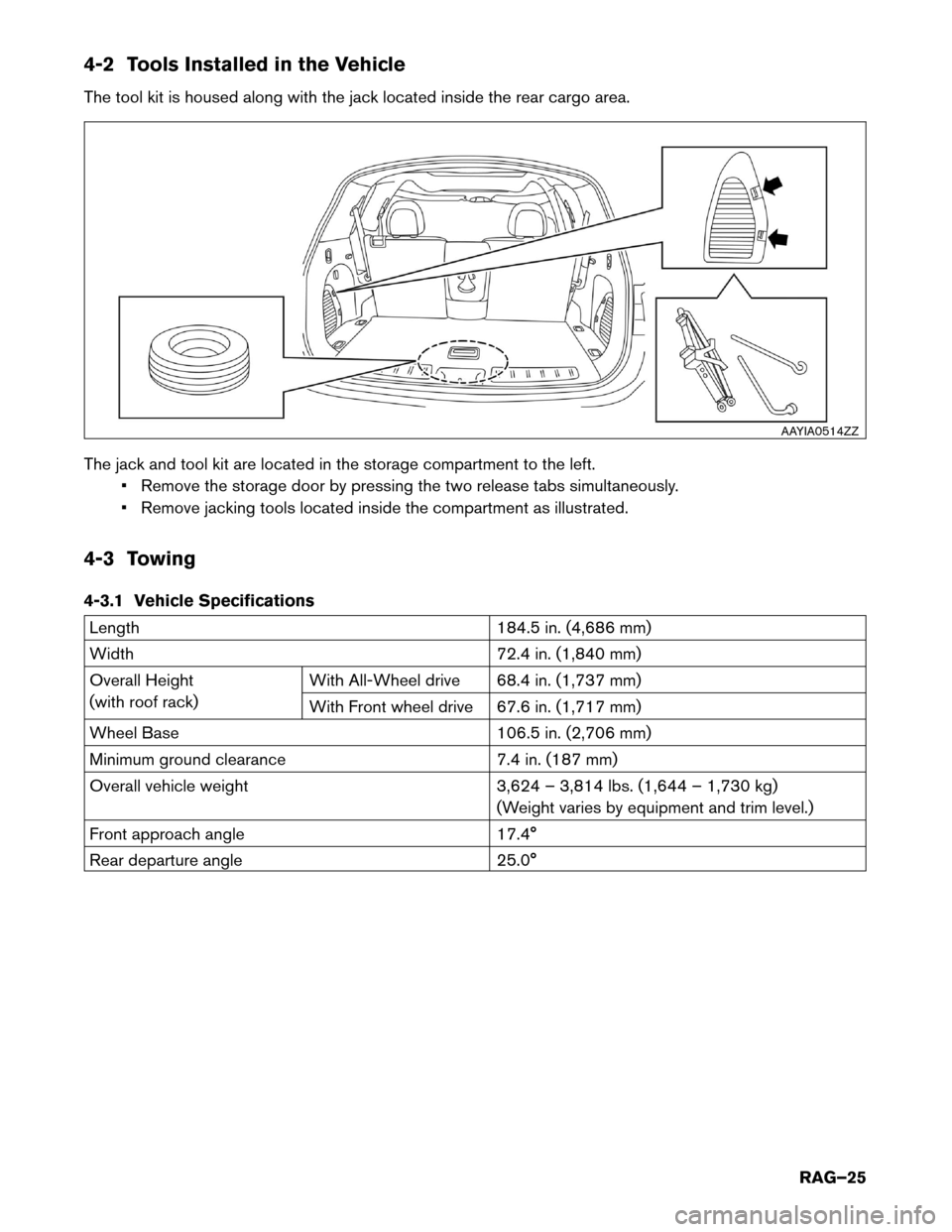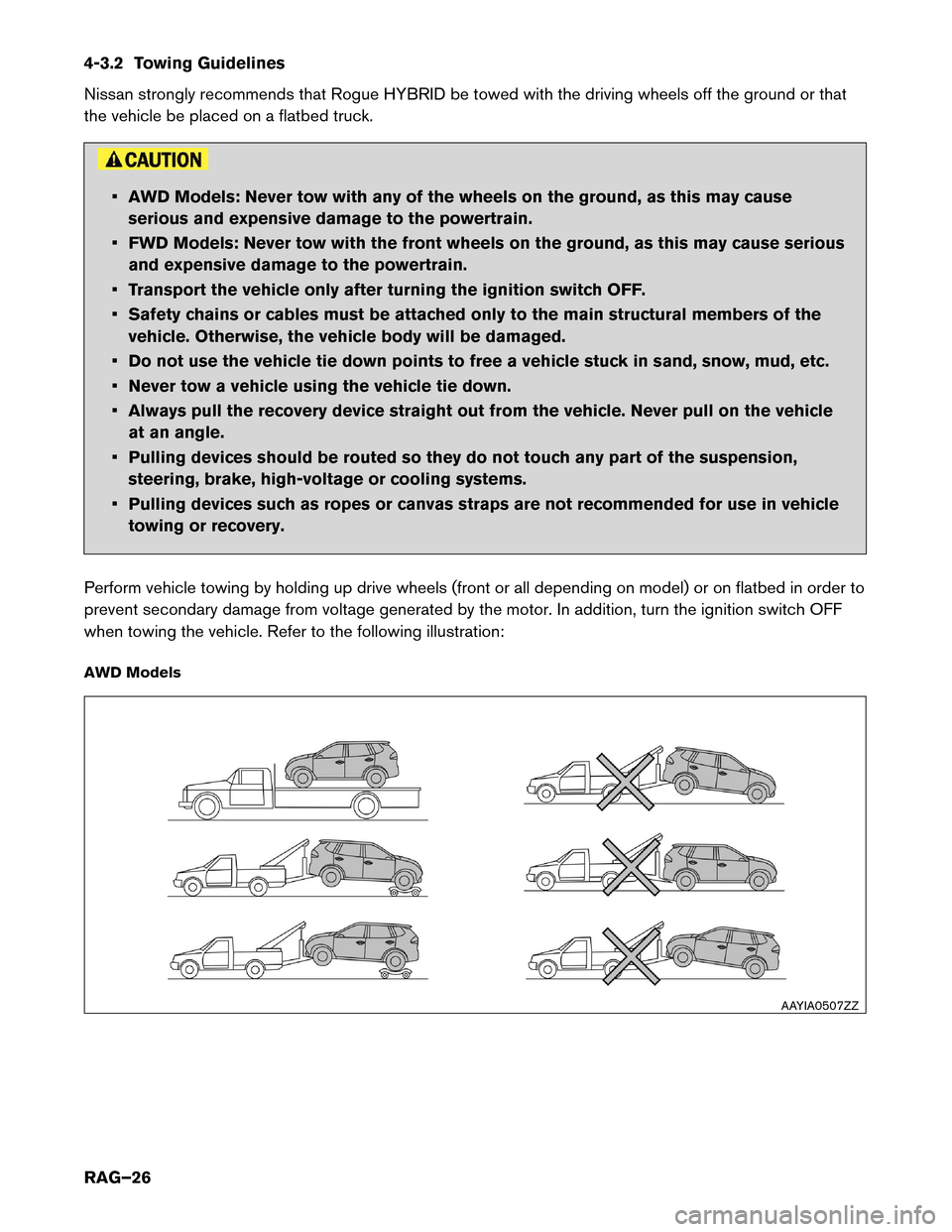towing NISSAN ROGUE HYBRID 2017 2.G Roadside Assistance Guide
[x] Cancel search | Manufacturer: NISSAN, Model Year: 2017, Model line: ROGUE HYBRID, Model: NISSAN ROGUE HYBRID 2017 2.GPages: 38, PDF Size: 2.41 MB
Page 4 of 38

4. ROADSIDE ASSISTANCE . . . . . . . . . . . . . . . . . . . . . . . . . . . . . . . . . . . . . . . . . . . . . . . .
. . . . . RAG–22
4-1 JUMP STARTING . . . . . . . . . . . . . . . . . . . . . . . . . . . . . . . . . . . . . . . . . . . . . . . . . . . . . . . RAG–22 4-1.1 JUMP STARTING PROCEDURES . . . . . . . . . . . . . . . . . . . . . . . . . . . . . . . . . . . . . RAG–23
4-1.2 SHIFT SELECTOR LEVER LOCK RELEASE . . . . . . . . . . . . . . . . . . . . . . . . . . . . . . RAG–24
4-2 TOOLS INSTALLED IN THE VEHICLE . . . . . . . . . . . . . . . . . . . . . . . . . . . . . . . . . . . . . . . RAG–25
4-3 TOWING . . . . . . . . . . . . . . . . . . . . . . . . . . . . . . . . . . . . . . . . . . . . . . . . . . . . . . . . . . . . . . RAG–25 4-3.1 VEHICLE SPECIFICATIONS . . . . . . . . . . . . . . . . . . . . . . . . . . . . . . . . . . . . . . . . . . RAG–25
4-3.2 TOWING GUIDELINES . . . . . . . . . . . . . . . . . . . . . . . . . . . . . . . . . . . . . . . . . . . . . . RAG–26
4-3.3 USE OF VEHICLE EQUIPPED HOOKS FOR RECOVERY OPERATIONS . . . . . . . RAG–27
4-4 JACKING UP THE VEHICLE AND CHANGING A TIRE . . . . . . . . . . . . . . . . . . . . . . . . . . RAG–28
5. STORING THE VEHICLE . . . . . . . . . . . . . . . . . . . . . . . . . . . . . . . . . . . . . . . . . . . . . . . . . . . . . . RAG–32 5-1 DANGER SIGN EXAMPLE . . . . . . . . . . . . . . . . . . . . . . . . . . . . . . . . . . . . . . . . . . . . . . . . RAG–32
5-2 REMOVING THE SERVICE PLUG . . . . . . . . . . . . . . . . . . . . . . . . . . . . . . . . . . . . . . . . . . RAG–34
RAG–4
Page 19 of 38

3-4 Turning OFF the Ignition Switch
1. Check the READY indicator status. If it is ON, the high-voltage system is active.
2.
Press the ignition switch once to turn OFF the high-
voltage system. Then verify whether the READY indicator is OFF.
3.
If possible, keep the Nissan Intelligent Key
®at least
5 meters (16 feet) away from the vehicle to prevent
accidentally turning ON the hybrid system while the
roadside assistance is in progress.
3-5 Water Submersion DANGER
Damage level of submerged vehicle may not be apparent. Handling a submerged
vehicle
without appropriate Personal Protective Equipment (PPE) will result in serious
injury or death from electrical shock. • The ignition switch of the submerged vehicle must be turned OFF first, if possible.
Then
the vehicle must be completely out of the water and drained to avoid electrical
shock.
• If the vehicle is in the water, to avoid electrical shock NEVER touch the high-voltage
components,
harnesses or service plug. PPE must always be worn when touching or
working on high-voltage components.
Only first responders wearing appropriate Personal Protective Equipment (PPE) should shut down the
vehicle. After shut down, standard towing/recovery procedures can be used. Refer to 4-3 Towing
(RAG–25) . AAYIA0516ZZ
HOLD
AAYIA0446ZZ
RAG–19
Page 25 of 38

4-2 Tools Installed in the Vehicle
The
tool kit is housed along with the jack located inside the rear cargo area.
The jack and tool kit are located in the storage compartment to the left. • Remove the storage door by pressing the two release tabs simultaneously.
• Remove jacking tools located inside the compartment as illustrated.
4-3 Towing
4-3.1 Vehicle Specifications Length
184.5
in. (4,686 mm)
Width 72.4 in. (1,840 mm)
Overall Height
(with roof rack) With All-Wheel drive 68.4 in. (1,737 mm)
With Front wheel drive 67.6 in. (1,717 mm)
Wheel Base 106.5 in. (2,706 mm)
Minimum ground clearance 7.4 in. (187 mm)
Overall vehicle weight 3,624 – 3,814 lbs. (1,644 – 1,730 kg)
(Weight varies by equipment and trim level.)
Front approach angle 17.4°
Rear departure angle 25.0° AAYIA0514ZZ
RAG–25
Page 26 of 38

4-3.2 Towing Guidelines
Nissan
strongly recommends that Rogue HYBRID be towed with the driving wheels off the ground or that
the vehicle be placed on a flatbed truck. • AWD Models: Never tow with any of the wheels on the ground, as this may cause
serious
and expensive damage to the powertrain.
• FWD Models: Never tow with the front wheels on the ground, as this may cause serious and expensive damage to the powertrain.
• Transport the vehicle only after turning the ignition switch OFF.
• Safety chains or cables must be attached only to the main structural members of the vehicle. Otherwise, the vehicle body will be damaged.
• Do not use the vehicle tie down points to free a vehicle stuck in sand, snow, mud, etc.
• Never tow a vehicle using the vehicle tie down.
• Always pull the recovery device straight out from the vehicle. Never pull on the vehicle at an angle.
• Pulling devices should be routed so they do not touch any part of the suspension, steering, brake, high-voltage or cooling systems.
• Pulling devices such as ropes or canvas straps are not recommended for use in vehicle towing or recovery.
Perform vehicle towing by holding up drive wheels (front or all depending on model) or on flatbed in order to
prevent secondary damage from voltage generated by the motor. In addition, turn the ignition switch OFF
when towing the vehicle. Refer to the following illustration:
AWD Models AAYIA0507ZZ
RAG–26